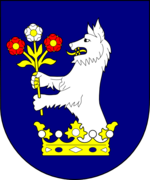Hungarian heraldry

Hungarian heraldry generally follows German heraldry in its artistic forms, but has its own distinctive character. It is classified to Central and Eastern European heraldry.
Private armory
One of the most common devices found on Hungarian shields is a symbol of the many
Most Hungarian
In many cases mantling has more than two tinctures. The barred helm is normally used, but this is not a rule. There are few Hungarian arms without a crest coronet.
Due to great demand of soldiers during the wars against the Turks in the 16th and 17th centuries, sometimes a whole garrison of 80 to 120 soldiers was raised to nobiliary rank, being granted one coat of arms for all of them to share.
Official armory

The
The red and white stripes were the symbol of the
The coat of arms with the stripes on the dexter half and the cross on the hills on the sinister half appeared during the reign of
The three green hills represent the mountains Tátra, Mátra and Fátra (made up of the Veľká Fatra and Malá Fatra ranges).
-
Coat of arms of the Hungarian town Komádi
-
Coat of arms of Révay family
-
Modern coat of arms of Hungary (1990–present)
-
Coat of arms of Hungary under communist rule (1957-1990)
Vocabulary
- coat of arms = címer
- crest = sisakdísz
| Tincture | Heraldic name | Hungarian name |
|---|---|---|
| Metals - Fémek | ||
| Gold/Yellow | Or | arany |
| Silver/White | Argent | ezüst |
| Colours - Színek | ||
| Blue | Azure | kék |
| Red | Gules | piros |
| Purple | Purpure | bíbor |
| Black | Sable | fekete |
| Green | Vert | zöld |
See also
- Coat of arms of Hungary
- Historical coat of arms of Transylvania
- Nobility and royalty of the Kingdom of Hungary
Further reading
- de Tamáska de Baranch, Endre: The Evolution of the Hungarian Coat of Arms. Sarasota, 1979.
- Kezd, Bela Kezdy Vasarheli De: Totemistic Elements in Hungarian Armory, 1961.
References
- ^ von Warnstedt, Christopher. (October 1970). "The Heraldic Provinces of Europe". The Coat of Arms XI (84): 129-30.
- ^ Thomas Woodcock & John Martin Robinson. The Oxford Guide to Heraldry. (Oxford University Press, New York: 1988), 28-32.
- ^ ISBN 9780486249933.
- Carl-Alexander von Volborth: Heraldry: Customs, Rules, and Styles Poole, Dorset, New Orchard Editions, 1981, pp. 120–122
External links
- College of the Hereditary Nobility of Hungary and Transylvania Archived 2019-08-16 at the Wayback Machine
- A Note on Hungarian Heraldry from François Velde's Heraldica website
- "Main characteristics of Hungarian heraldry". Rakonczay Gergely. Archived from the original on 2009-09-03. Retrieved 2016-01-31.
- Heraldikai lexikon - Hungarian dictionary of arms
- Magyar Címer Portál - Hungarian Coat of Arms Portal




